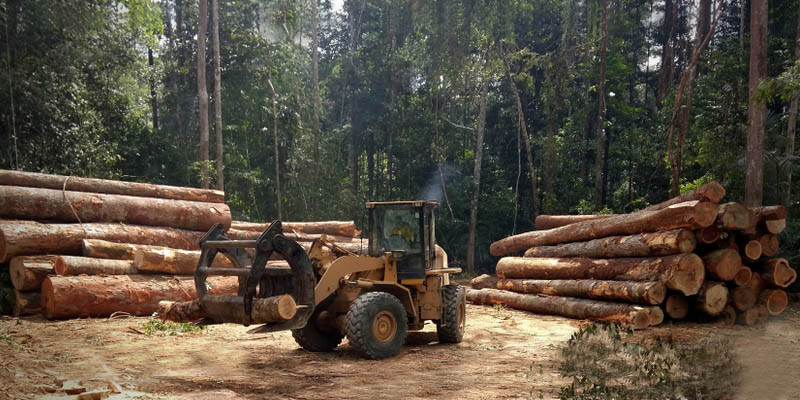We explain what the ecological footprint is, and how it is calculated. In addition, we explore its characteristics, classification and importance, and discuss the ecological overshoot.

What is the ecological footprint?
The ecological footprint is an indicator that measures human impact on the environment. The concept was first introduced by Mathis Wackernagel and William Rees in 1996. It is key data for measuring the sustainability of human activity, and assessing its impact on the natural environment.
The ecological footprint measures the quantity of natural resources used to produce the goods and services consumed, as well as the amount of waste and gas emissions generated. The measurement unit is the hectare, which represents the land area required to sustain economic activities over a year.
Thus, the ecological footprint allows for comparing the impact, risk, and benefit of human activity and social organizations.
The ecological footprint can be measured at a country, city, factory, or individual scale. At present, it is estimated that each person on Earth needs 2.7 hectares of land to meet their needs over an entire year.
Frequently asked questions
What is the ecological footprint?
It is an indicator that measures both the amount of resources used for the production of consumer goods and services, and the waste and pollution from their manufacturing process.
What is the purpose of knowing the ecological footprint?
The purpose is to quantify the negative impact human activity has on the planet in order to reduce or reverse it through sustainable actions.
What would be an example of an ecological footprint measurement?
The calculation of the ecological footprint produced by the manufacture of a cell phone (not considering the impact of its subsequent use) includes aspects such as:
- The amount of raw materials and energy, like technological inputs, minerals, transportation, and distribution.
- The waste generated during the manufacturing process, such as chemical substances, ecosystem degradation due to mineral extraction, and carbon emissions, among other waste.
- See also: Greenhouse effect
What does the ecological footprint measure?
The concept of ecological footprint emerged in 1996 from the studies of William Rees and Mathis Wackernagel. These scientists wanted to come up with a unique ecological concept that could measure the sustainability of human lifestyles and their direct and indirect relationship with nature’s capacity to regenerate.
Since then, attempts have been made to implement global measurement methods. The Global Footprint Network is an organization dedicated to calculating and monitoring global ecological footprint based on a standardized method. This method assesses the amount of land and water needed both to produce the resources consumed and absorb the resources generated. It is expressed in global hectares per person.
The Global Footprint Network also assesses the biocapacity of regions, that is, the capacity of a given area to produce natural resources and absorb waste. By comparing a region's ecological footprint with its biocapacity, it can be determined whether a region is consuming more resources than it can regenerate, which could lead to ecological impacts such as environmental degradation and biodiversity loss.
How is the ecological footprint calculated?

The calculation of the ecological footprint is based on a matrix that allocates demands at the individual level, including elements such as necessary land area for food production, forest area required to absorb carbon dioxide emissions, usable sea area, land area needed for infrastructure construction, and energy consumed, among others.
Elements that protect biodiversity and preserve ecosystem integrity are also included in the calculation. This biodiversity reserve is estimated at 12% of the total land area assessed.
The ecological footprint then arises from the sum of the hectares needed to satisfy the population's consumption demand plus an additional 12% for the protection of ecosystems.
What is Earth Overshoot Day?
Earth Overshoot Day marks the estimated date when humanity has consumed all the ecological resources the planet can regenerate in a year.
Earth Overshoot Day for 2022 was July 28. This means that all resources consumed by humans beyond that date will not be replenished. This generates a "debt" to nature that cannot be sustained over time and has severe impacts on ecosystems and societies.
Types of ecological footprint

Depending on the impact that human activity has on the natural environment, the ecological footprint can be classified into:
- Direct ecological footprint. It is concerned with the direct action of human activity on nature. For example: the impact of agriculture, livestock farming, or fishing.
- Indirect ecological footprint. It does not affect nature directly, but produces effects that indirectly impact the environment. For example: transportation and electricity production.
- Collective ecological footprint. It is the total impact of human activity on a given community or region. It includes both direct and indirect footprints.
Other types of "footprints" that are measured include:
- Carbon footprint. It measures the amount of greenhouse gas emissions produced by an individual, company, or country. It is expressed in tons of carbon dioxide equivalent (tCO2 e).
- Water footprint. It measures the amount of freshwater used directly or indirectly in the production of goods and services consumed by an individual, company, or country.
Ecological footprint map

The measurement of the ecological footprint reveals inequalities in resource use and waste production between different regions. Developed countries with the highest consumption rates have an extremely high ecological footprint. This means they consume more resources than their land area can provide.
It also means they produce more waste than their land area can absorb, which is why waste is often exported to other regions.
The human ecological footprint map is divided into:
- High footprint countries. These are highly industrialized countries with great demand for raw materials and energy, such as the United States, most European countries, Australia, Japan, China, the United Arab Emirates, and Russia.
- Medium footprint countries. These countries have an ecological footprint above the global average but below that of high-demand countries. They are countries with large populations and high economic growth, such as Brazil, Indonesia, Nigeria, India, and Mexico.
- Low footprint countries. These are poor or sparsely populated countries with a low human development index. Most African countries fall into this group.
What economic activities generate the biggest ecological footprint?
The activities with the biggest ecological footprint worldwide are:
- Energy production. The use of fossil fuels to produce energy is one of the main causes of greenhouse gas emissions, contributing significantly to the ecological footprint.
- Intensive agriculture and livestock farming. Large-scale food production requires large amounts of water, energy, and land. In addition, the use of pesticides and chemical fertilizers may cause environmental pollution.
- Transportation. Vehicles that run on fossil fuels for the transport of people and goods emit large amounts of greenhouse gases.
- Construction. The construction of buildings, roads, and large infrastructure requires a high amount of materials and energy, which can lead to the degradation and destruction of the natural environment where they are extracted.
- Industry. The large-scale production of goods requires a significant amount of materials and energy, often emitting air pollutants into the environment.
Importance of the ecological footprint

The concept of ecological footprint is important because it provides a quantitative measure of human impact on the environment in a given area.
Measuring the ecological footprint enables assessing the sustainability of economic and consumption activities. If the ecological footprint of a community, city, or country is bigger than its regenerative biocapacity, it means that resources are consumed beyond the point they can regenerate, leading to an "ecological deficit".
Moreover, the ecological footprint can help governments and society at large to better understand the effects of economic activities and the use of natural resources on the environment. It can also be a useful tool for identifying priority areas for action to reduce the ecological footprint and improve economic sustainability.
Explore next:
References
- Global Footprint Network (2023). Measure what you treasure. https://www.footprintnetwork.org/
- Wackernagel, M y Rees, W (2001). Nuestra huella ecológica: reducción del impacto humano en la Tierra. Lom.
WWF (2021). Claves para entender el sobregiro ecológico de la Tierra. https://www.wwf.cl/
Was this information useful to you?
Yes NoThank you for visiting us :)